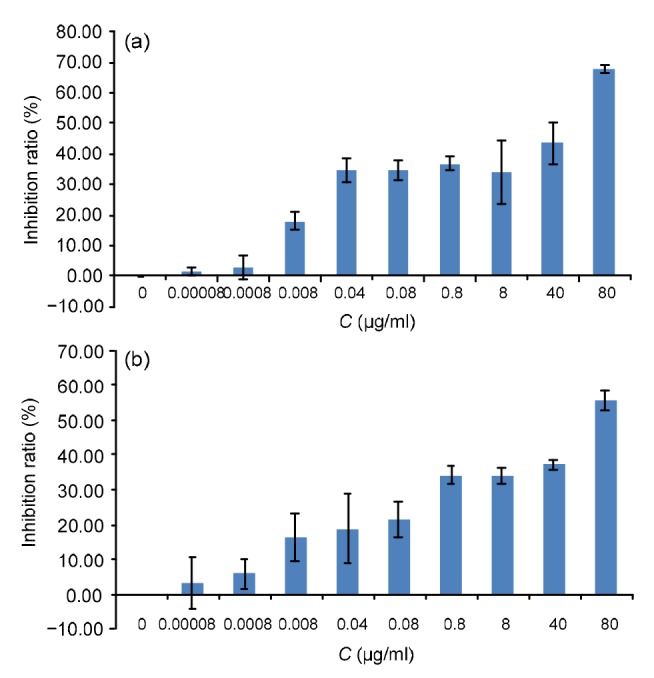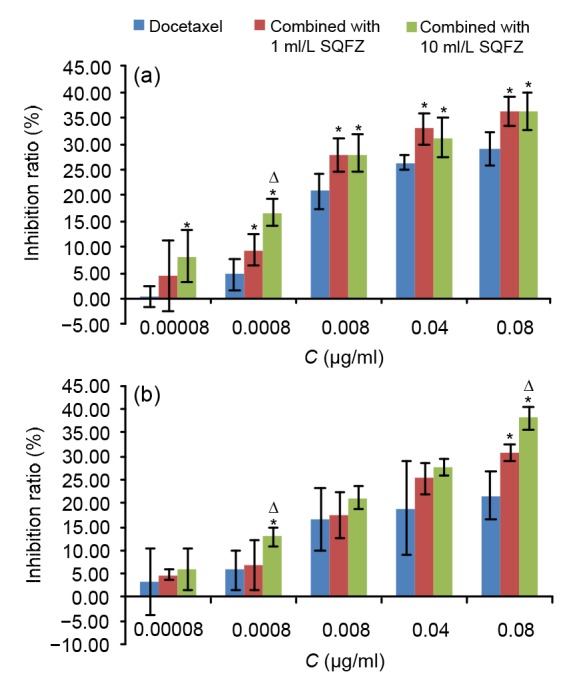This study investigated the anticancer effect of Shenqi Fuzheng (SQFZ) injection combined with docetaxel on lung cancer cell lines of A549 and Lewis lung cancer (LLC). SQFZ injection alone cannot inhibit the vitality of lung cancer cells, but the antitumor activity of SQFZ combined with docetaxel was significantly higher than that using docetaxel alone.
Lung cancer is one of the most common and deadliest malignancies in the world and in China (Stewart and Wild, 2014). Because sensory nerves are not developed, early and mid-stage of lung cancers often have no symptoms, unless the tumor invasion to the pleura has symptoms such as chest pain and coughing up blood (Granville and Dennis, 2005). More than half of lung cancers are diagnosed at a late stage and are very difficult to cure. SQFZ injection is a famous traditional Chinese medicine injection, which can improve the immunity of patients after chemotherapy, so it is widely used for lung cancer combined with chemotherapy in China. One study of SQFZ injection treatment for advanced non-small cell lung cancer (NSCLC) patients found that CD4+ and CD4+/CD8+ significantly increased after treatment, and CD8+ declined obviously, showing that SQFZ injection can significantly improve the body’s immune function (Kong et al., 2014). However, SQFZ injection itself has no effect on antitumor efficacy (Zhong et al., 2015). Docetaxel is one of the first-line chemotherapeutic drugs for lung cancer (Zhang et al., 2011). Bruno et al. (1998) showed that 5 h after intravenous (IV) administration of docetaxel for lung cancer patients (a dose of 2 mg/kg), plasma concentrations of docetaxel were below 0.1 μg/ml in clinical use. This study investigated the inhibition rate of low concentrations of docetaxel combined with SQFZ injection in two lung cancer cells by 3-(4,5-dimethylthiazol-2-yl)-2,5-diphenyl tetrazolium bromide (MTT) assay.
The lung cancer cell lines A549 and LLC were purchased from the Cell Library Committee of the Chinese Academy of Sciences (Shanghai, China). Both cell lines were grown as monolayers in Dulbecco’s modified Eagle’s medium (DMEM; Gibico, USA) supplemented with 10% (0.1 g/ml) heat-inactivated fetal bovine serum (FBS; Gibico) and 1% (0.01 g/ml) penicillin-streptomycin solution (Gibco) at 37 °C with 5% CO2/95% air. Docetaxel was purchased from Newbio Pharm-Tech (Wuhan, China). SQFZ injection was purchased from Lizon Group Limin Pharmaceutical (Zhuhai, China). Docetaxel used in vitro was dissolved in dimethyl sulfoxide (DMSO; Sigma, USA).
Cells were seeded in 96 microtiter plates with flat-bottomed wells (Corning, NY, USA) in a total volume of 100 μl of culture medium at a density of 1×105 cells/ml. Plates were then incubated at 37 °C in a 5% CO2 atmosphere. After 24 h, the medium was removed and replaced with a fresh medium containing various concentrations of the compounds. After incubation for 24 h, 20 μl of 5 mg/ml MTT (Amersco, USA) solution in culture medium was added to each well and the mixtures were incubated at 37 °C until blue deposits were visible. The colored metabolite was then dissolved in DMSO. Absorbance was measured at 490 nm with a Multiskan™ GO microplate reader (Thermo, USA). Inhibition ratio (%)=(1−A t/A c)×100%, where A t and A c are absorbances of treated and control samples, respectively. All experiments were repeated in quintuplicate (n=5). The data were analyzed by the Wilcoxon two-sample test (SAS 9.3). Statistical significance was considered at P<0.05.
The result shows that using SQFZ injection with five concentrations alone makes no difference from the comparison. Therefore, it proves that SQFZ injection has no inhibition to two lung cancer cells. The results of using docetaxel with nine concentrations alone to A549 and LLC cells are shown in Fig. 1. In order to study the combined effect of SQFZ injection and low-concentration docetaxel, five low concentrations of docetaxel and two concentrations of SQFZ injection were selected. The inhibition ratios of five low concentrations of docetaxel alone or combined with 1 and 10 ml/L of SQFZ injection are shown in Fig. 2.
Fig. 1.

Inhibition rates of nine concentrations (C) of docetaxel to A549 (a) and LLC (b) cells
The inhibition rate increased with the concentration of docetaxel. All data are expressed as mean±standard deviation (SD), with n=5
Fig. 2.

Inhibition rates of different concentrations (C) of docetaxel combined with SQFZ injection to A549 (a) and LLC (b) cells
The inhibition rates of two cells after the treatment of SQFZ injection were increased. * P<0.05, compared with the docetaxel alone group; ∆ P<0.05, compared with the gourp of 1 ml/L SQFZ injection combined with docetaxel. All data are expressed as mean±standard deviation (SD), with n=5
As can be seen from the above histogram, docetaxel has increased the inhibition rate to cancer cells when used with two concentrations of SQFZ injection together. The experiments have the same trend considering the average of inhibition ratio. The effects of SQFZ on the two cell lines were different, i.e. more effective on A549 than on LLC. We see that when the concentration of docetaxel is 0.0008 μg/ml, it has the highest combination effect.
In recent times lung cancer has accounted for most cancer-related deaths in both men and women. Docetaxel has demonstrated anticancer effects in vivo and in vitro against various cancers, such as lung, breast, and gastric tumors (Saloustros et al., 2008). However, the side effects of chemotherapy with the increase of the dose are increasingly obvious. In order to remit the side effect of chemotherapy, SQFZ injection is widely used in clinics in China. Docetaxel can maintain a curative effect at very low concentration when combined with SQFZ injection.
This study has preliminarily shown that SQFZ injection can increased the inhibition rate of docetaxel on lung cancer cells by MTT assay. The results of A549 and LLC cells were slightly different. The reason for this may lie in the fact that the two cell types are different, so the response to the drug was also different. Under the light microscope, there were no significant changes in the morphology of the two cell types before and after administration of SQFZ. In order to make a more in-depth study of the mechanism, we plan haematoxylin and eosin staining in the follow-up study, as well as immunohistochemistry and electron microscope observation of cell morphology, which will facilitate more subtle examination. At the same time, cell cycle and apoptosis will be studied.
This experiment proves that the inhibition rate of docetaxel in low concentrations to lung cancer cells can be increased using SQFZ injection, so the treatment effect of using a low concentration of docetaxel together with SQFZ injection can also be comparable to the effect of high-concentration docetaxel but with lower side effect. This study in part showed the rationality of using these two drugs in combination in clinical practice.
Footnotes
Project supported by the Beijing Science and Technology Star Project (No. xx2015A048), China
Compliance with ethics guidelines: Bo-yu DONG, Cheng WANG, Li TAN, Ning TAN, Meng-di ZHAO, Yang LU, and Shou-ying DU declare that they have no conflict of interest.
This article does not contain any studies with human or animal subjects performed by any of the authors.
References
- 1.Bruno R, Hille D, Riva A, et al. Population pharmacokinetics/pharmacodynamics of docetaxel in phase II studies in patients with cancer. J Clin Oncol. 1998;16(1):187–196. doi: 10.1200/JCO.1998.16.1.187. (Available from: http://dx.doi.org/10.1200/JCO.1998.16.1.187) [DOI] [PubMed] [Google Scholar]
- 2.Granville CA, Dennis PA. An overview of lung cancer genomics and proteomics. Am J Respir Cell Mol Biol. 2005;32(3):169–176. doi: 10.1165/rcmb.F290. (Available from: http://dx.doi.org/10.1165/rcmb.F290) [DOI] [PubMed] [Google Scholar]
- 3.Kong TD, Liu DN, Gao WY, et al. Effect of Shenqi Fuzheng injection on immune function and quality of life in advanced non-small cell lung cancer patients with palliative treatment. China J Chin Med. 2014;29(8):1097–1098. (in Chinese) [Google Scholar]
- 4.Saloustros E, Mavroudis D, Georgoulias V. Paclitaxel and docetaxel in the treatment of breast cancer. Expert Opin Phamacother. 2008;9(15):2603–2616. doi: 10.1517/14656566.9.15.2603. (Available from: http://dx.doi.org/10.1517/14656566.9.15.2603) [DOI] [PubMed] [Google Scholar]
- 5.Stewart BW, Wild CP. World Cancer Report 2014. World Health Organization; 2014. The global and regional burden of cancer; pp. 16–54. [Google Scholar]
- 6.Zhang WY, Zhang WM, Wang L, et al. Sequence-dependent effect of docetaxel with gefitinib on the proliferation and signal protein expression of human lung adenocarcinoma cell SPC-A1. China J Lung Cancer. 2011;14(5):385-390(in Chinese):385–390 (in Chinese). doi: 10.3779/j.issn.1009-3419.2011.05.01. (Available from: http://dx.doi.org/10.3779/j.issn.1009-3419.2011.05.01) [DOI] [PMC free article] [PubMed] [Google Scholar]
- 7.Zhong MW, Li QZ, Ye HQ, et al. Clinical observation of shenqi fuzheng injection combing docetaxel and lobaplatin in treatment of old middle-advanced stage lung cancer. Clin J Tradit Chin Med. 2015;27(5):676-679(in Chinese):676–679 (in Chinese). (Available from: http://dx.doi.org/10.16448/j.cjtcm.2015.0257) [Google Scholar]


